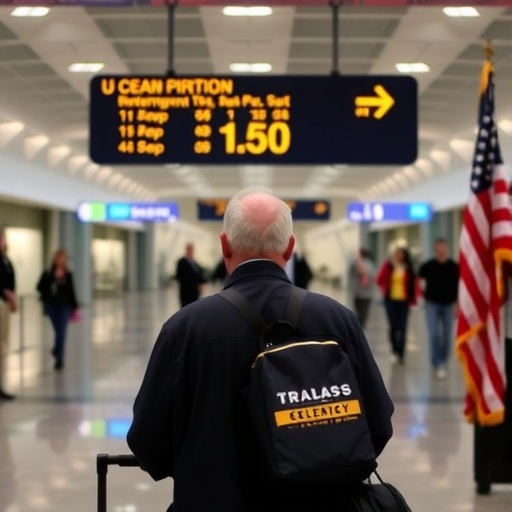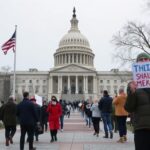U.S. economy Slows as Government Shutdown Disrupts Air Travel and Federal Services, Warns Treasury Secretary Bessent
In a stark reminder of how political gridlock can cascade into everyday economic pain, the prolonged U.S. government shutdown is now visibly dragging down the nation’s economic momentum. Treasury Secretary Scott Bessent issued a dire warning on Friday, highlighting severe disruptions to air travel and broader federal services that could shave off key growth points from the U.S. economy. As the standoff in Congress enters its third week, furloughed workers, delayed military paychecks, and chaotic airports are painting a picture of mounting frustration and financial strain across the country.
- Treasury Secretary Bessent Sounds Alarm on Shutdown’s Economic Ripple Effects
- Air Travel Grounded: FAA Staffing Shortages Spark Nationwide Delays
- Congressional Standoff Escalates: Military Pay and Federal Services Hang in the Balance
- Economic Indicators Flash Red: Shutdown’s Broader Drag on Growth and Confidence
- Path Forward: Bipartisan Talks Heat Up Amid Calls for Shutdown Resolution
The shutdown, triggered by deep partisan divides over budget priorities and immigration reforms, has already cost the economy an estimated $11 billion in lost productivity, according to preliminary figures from the Congressional Budget Office. But experts fear the toll could escalate rapidly if the impasse persists, with air traffic control systems teetering on the edge of overload and consumer confidence plummeting. “This isn’t just about Washington anymore—it’s hitting Main Street, from delayed flights to shuttered national parks,” Bessent stated during a press briefing at the Treasury Department. His comments underscore the growing consensus that the U.S. economy, which had been chugging along at a modest 2.5% growth rate in the third quarter, now faces a potential downgrade to sub-2% territory if the crisis deepens.
Treasury Secretary Bessent Sounds Alarm on Shutdown’s Economic Ripple Effects
Treasury Secretary Scott Bessent, a seasoned Wall Street veteran appointed to steer the nation’s finances through turbulent times, did not mince words when addressing the shutdown’s fallout. In an exclusive interview with CNBC, Bessent revealed that internal Treasury models project a 0.5% contraction in GDP for every additional month the shutdown lingers. “The U.S. economy is resilient, but it’s not invincible,” he said. “We’re seeing immediate hits to consumer spending and business investment, exacerbated by uncertainties in air travel and federal contracting.”
Bessent’s warnings come at a pivotal moment. The shutdown, now the longest in modern U.S. history surpassing the 2018-2019 episode, has frozen pay for over 800,000 federal employees and contractors. This includes critical roles in the Department of Transportation, where air traffic controllers are working without pay, leading to heightened fatigue and error risks. Drawing from his experience at hedge funds like Key Square Group, Bessent emphasized the interconnectedness of government operations and private sector vitality. “When federal services grind to a halt, supply chains stutter, and that’s a recipe for broader economic slowdown,” he noted.
Economists echo Bessent’s concerns. A report from Moody’s Analytics estimates that the shutdown could reduce fourth-quarter growth by up to 0.3 percentage points, with spillover effects into 2025. This is particularly alarming given recent inflationary pressures and a softening labor market, where unemployment ticked up to 4.2% last month. The Treasury chief also pointed to the stock market’s reaction, with the Dow Jones Industrial Average dipping 1.2% in the past week amid fears of prolonged uncertainty.
Air Travel Grounded: FAA Staffing Shortages Spark Nationwide Delays
Nowhere is the shutdown’s impact more tangible than in the skies, where air travel disruptions are snarling commutes and costing airlines millions. The Federal Aviation Administration (FAA), operating on borrowed time without full funding, has reported a 15% increase in flight delays since the shutdown began. Air traffic controllers, numbering over 14,000, are among the essential workers required to show up despite missing paychecks—a situation that’s breeding exhaustion and safety concerns.
Take the case of Chicago’s O’Hare International Airport, one of the busiest hubs in the world. Last week, a controller shortage led to a two-hour ground stop, stranding thousands of passengers and causing ripple delays across the Midwest. “We’ve had to reroute flights and extend shifts, but our people are running on fumes,” said an anonymous FAA supervisor speaking to Reuters. Major carriers like Delta and United have issued travel advisories, warning of potential cancellations if the shutdown extends into next month.
The economic stakes are high. The U.S. travel industry supports 15.7 million jobs and contributes $2.9 trillion to the GDP annually, per the U.S. Travel Association. Disruptions here don’t just inconvenience leisure travelers; they hammer business travel, which accounts for 40% of airline revenue. A study by the Airlines for America trade group projects $1.5 billion in lost revenue for carriers in the first month alone, with passengers facing an average $200 in extra costs from rebookings and hotels.
Moreover, the shutdown’s toll on air travel extends to cargo operations. FedEx and UPS, reliant on FAA oversight, have seen delivery times stretch by up to 24 hours, disrupting e-commerce giants like Amazon. “This is a chokepoint for the entire logistics network,” explained aviation analyst Henry Harteveldt of Atmosphere Research Group. As Congress dithers, the fear is that these delays could evolve into full-blown cancellations, further eroding confidence in the U.S. economy’s infrastructure.
Congressional Standoff Escalates: Military Pay and Federal Services Hang in the Balance
At the heart of the crisis is a bitter standoff in Congress, where Democrats and Republicans remain locked in debate over a $1.2 trillion spending bill laced with contentious riders on border security and climate initiatives. House Speaker Mike Johnson has vowed not to budge on GOP priorities, while Senate Majority Leader Chuck Schumer accuses Republicans of holding the economy hostage. “This shutdown is a manufactured crisis that’s hurting real Americans,” Schumer declared on the Senate floor last Tuesday.
The human cost is stark. Over 2 million military personnel face delayed paychecks for the first time since the Civil War, prompting urgent bipartisan calls for a short-term fix. Defense Secretary Lloyd Austin testified before a joint committee that the Pentagon is dipping into reserves to cover salaries, but non-essential training and maintenance are being deferred, potentially compromising readiness. “Our troops deserve better than this political theater,” Austin said, his voice laced with frustration.
Federal services beyond defense are crumbling too. National parks, visited by 330 million people yearly, are largely closed, slashing tourism revenue in gateway communities by an estimated $76 million per week. The IRS, already understaffed, has halted audits and taxpayer assistance, delaying refunds worth billions. Small businesses waiting on SBA loans are in limbo, with approvals down 60% since the shutdown started. “Congress needs to wake up—this isn’t abstract policy; it’s families skipping meals,” warned National Small Business Association President Todd McDonald.
Behind the scenes, negotiations are faltering. A proposed compromise bill, floated last week, included $5 billion for border wall funding but was shot down by progressive Democrats. With midterm elections looming, both sides are digging in, prolonging the agony for the U.S. economy.
Economic Indicators Flash Red: Shutdown’s Broader Drag on Growth and Confidence
The shutdown’s tentacles are reaching deep into the U.S. economy, with early indicators signaling a slowdown that could rival the 2013 sequestration cuts. Retail sales, a bellwether for consumer health, fell 0.8% in November—partly attributed to furlough anxieties. Manufacturing PMI dipped below 50 for the first time in six months, reflecting supply chain hiccups tied to federal inspections.
Wall Street is jittery. Bond yields on 10-year Treasuries rose to 4.3%, as investors price in fiscal risks. The S&P 500 has shed 3% since the shutdown’s onset, with sectors like transportation and leisure hit hardest—Delta Airlines stock down 5%, Marriott International off 4%. “The uncertainty is toxic for investment decisions,” said Mark Zandi, chief economist at Moody’s Analytics. “Businesses are postponing hires and expansions, which could turn a temporary dip into a prolonged stall.”
Regionally, the impacts vary but are universally felt. In Washington D.C., local economies are reeling from lost federal spending, with hotels at 40% occupancy. Coastal states like Florida, dependent on tourism, report a 20% drop in visitor bookings. Even tech hubs like Silicon Valley are affected, as venture funding slows amid fears of reduced government R&D grants. A Federal Reserve survey of Beige Book districts notes “widespread mentions of shutdown-related headwinds,” from delayed infrastructure projects to stalled regulatory approvals.
Inflation adds another layer of complexity. While the shutdown might temper price pressures short-term by curbing demand, long-term disruptions could spike costs in air travel and shipping. The Consumer Price Index rose 3.2% year-over-year last month, and economists warn that persistent supply issues could push it higher, complicating the Federal Reserve’s rate-cut plans.
Women and minorities, often overrepresented in federal jobs, bear disproportionate burdens. The Bureau of Labor Statistics reports that 45% of affected workers are women, many heads of household. Community organizations in D.C. have distributed $10 million in emergency aid, but it’s a drop in the bucket against the $3,000 average monthly shortfall per furloughed family.
Path Forward: Bipartisan Talks Heat Up Amid Calls for Shutdown Resolution
As the shutdown’s economic scars deepen, glimmers of hope emerge from bipartisan talks aimed at averting catastrophe. President Biden hosted a White House summit with congressional leaders on Sunday, where Treasury Secretary Scott Bessent presented updated forecasts showing a potential $50 billion GDP hit by year’s end if no deal is reached. “We can’t let politics paralyze progress,” Biden urged, echoing sentiments from business lobbies like the U.S. Chamber of Commerce.
Potential resolutions include a clean continuing resolution to fund the government through March, coupled with a commission to tackle immigration reforms. Senate Republicans, led by Minority Leader Mitch McConnell, have signaled openness to such a framework, provided Democrats concede on certain spending caps. Meanwhile, House progressives are pushing for protections on social programs, complicating the path.
Looking ahead, recovery won’t be swift. Even if Congress acts swiftly, economists predict a lag in rebuilding confidence, with air travel normalizing only after FAA backlogs clear—potentially weeks. The U.S. economy could rebound with stimulus checks for furloughed workers, as proposed in a $20 billion relief package. Yet, the episode serves as a cautionary tale: in an era of razor-thin majorities, fiscal brinkmanship risks long-term damage to America’s global competitiveness.
For travelers and businesses, practical steps include monitoring FAA alerts and diversifying supply chains. As Bessent concluded in his briefing, “The U.S. economy will weather this storm, but only if Congress chooses unity over division.” The coming days will test whether lawmakers can deliver, or if the slowdown becomes the new normal.








